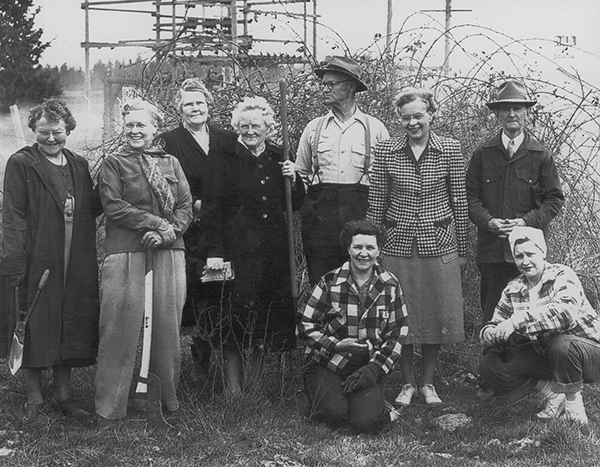Once the town cemetery, Pioneer Memorial Park is four acres of sprawling grass with trees, flowers and a short road that loops through the scenic park. To this day a few headstones remain as reminders of the park’s past use, although most of the bodies were removed from Pioneer Memorial Park and lain to rest at the current Sequim View Cemetery by 1919.
John Bell, the man behind the land now known as Pioneer Memorial Park, came from Fort Victoria where he worked for the Hudson Bay Company farm, according to Appendix C Sequim History of the Sequim Parks Master Plan.
Bell confiscated a boat after leaving the company and rowed across the Strait of Juan de Fuca to Clallam County where he voluntarily fought in the last of the Indian Wars, but not long after signed naturalization papers and filed a 160-acre homestead claim at what became the southeast corner of Sequim Avenue and Washington Street.
How it came to be
Originally the land now used as a park was dedicated to the board of Clallam County commissioners in 1888 by Bell for the use of a town cemetery, according Sequim Prairie Garden Club. By 1909 the land had been transferred to the Sequim Cemetery Association.
Once the cemetery outgrew the space Bell dedicated and a new cemetery elsewhere took its place, the land returned to nature. That is until the early 1940s when descendants of pioneers and the Sequim Prairie Garden Club began to clear the weeds, blackberry vines and debris accumulated in the abandoned cemetery.
By 1951 the Garden Club secured a 99-year lease of the park for $1 per year from the Sequim Cemetery Association. Shorty after the lease agreement members voted to officially name the old cemetery “Pioneer Memorial Park.”
The continuous dedication by the Garden Club to reshape the park won it a national award in 1967 in recognition of the “beautification project” at Pioneer Memorial Park, according to a Port Angeles Evening News 1969 news article clip. This award was one of many awards won throughout the years because of the Garden Club’s longtime devotion to Pioneer Memorial Park.
“We love our park,” Garden Club member Diane Lindsay said. “I like it because it’s quiet and I even refer it it as ‘serenity park’ sometimes.”
Remembering the past
As the park developed, various amenities were added and the landscaping continued to blossom. Picnic tables, a kitchen, clubhouse and restrooms slowly were established within the park and it became a place for social gathering, events and fundraisers. The name of Pioneer Memorial Park became fitting as nearly every tree, stone, artifact and garden within the park is in memory of a Sequim historical figure.
“We have a lot of history here in Sequim and the Garden Club also has enjoyed preserving that history,” Lindsay said.
In addition to original headstones left in a far corner of the park, an old canoe once used by the Quileute Tribe is nestled in the park. The canoe was donated by the Frick family. The park also is the resting place for a log cabin built in 1861 and donated by the Zaccardo family in memory of their mother. The canoe and historical cabin are just a couple examples of the elements found within Pioneer Memorial Park that honor people and things of the past.
The park, today
Though the City of Sequim now owns Pioneer Memorial Park, the Garden Club remains active in maintaining the park and managing the clubhouse. In 2002, the Garden Club signed a 50-year lease with the City of Sequim to secure the park’s future for many more years to come. The Garden Club has more than 40 members currently and they often are seen at Pioneer Memorial Park working on their gardens.
Pioneer Memorial Park may have served a variety of purposes for the community throughout the years, but it eventually evolved into the lush four acres it is today. Inside its boundaries, Pioneer Memorial Park encloses both its own rich history and historical bits of Sequim’s humble beginnings.
Reach Alana Linderoth at alinderoth@sequimgazette.com.



